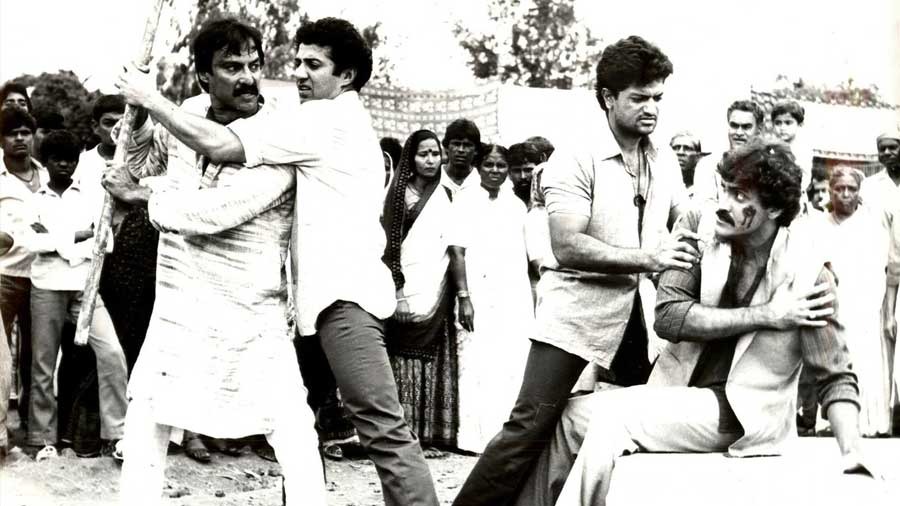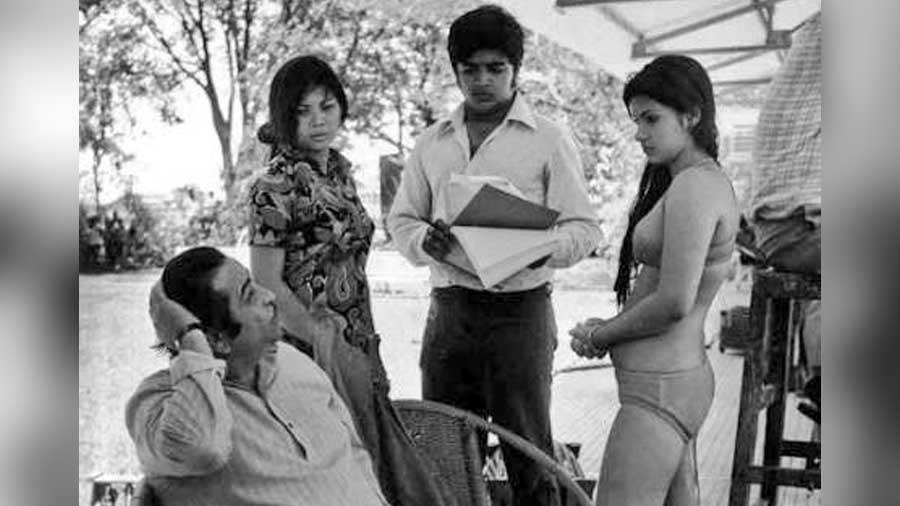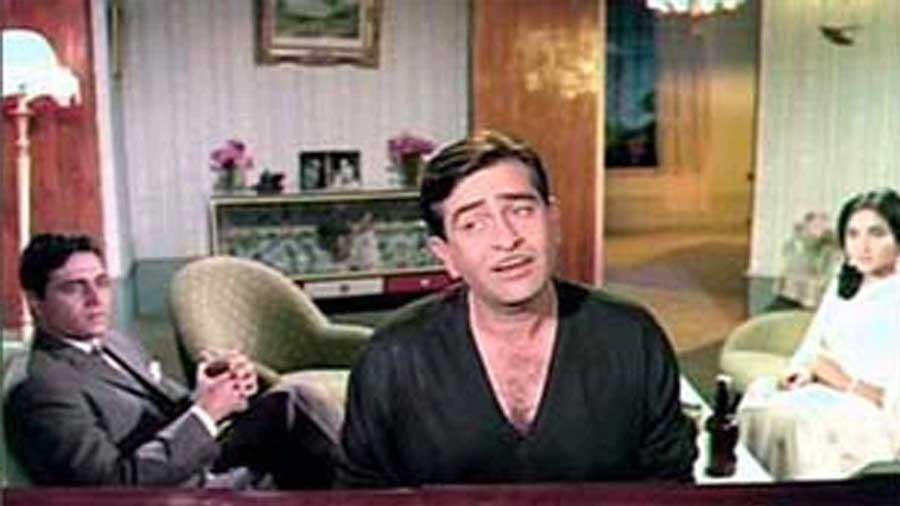For those growing up in the 1980s, often considered as the worst decade in the history of Hindi cinema, the films of one film-maker stood out both for their narrative flair and entertainment quotient, in a sea of mediocrity. From Love Story (1981) and Betaab (1983, a take on Shakespeare’s Taming of the Shrew), which gave new wings to the teenybopper romance in Hindi films, to classic action-dramas like Arjun (1985) and Dacait (1987), Rahul Rawail was unarguably the most exciting and influential film-maker of that period.
It’s a tribute to the films he crafted that even 40 years later they remain in the news as much for introducing stars like Kumar Gaurav and Sunny Deol as for their content. No Hindi film lover worth his salt will ever forget the umbrella sequence in Arjun – one that has now acquired a cultish status among action sequences in Hindi cinema. Even over 35 years later, I vividly recall the rush of adrenaline I experienced watching that sequence in a theatre. As do I remember being numbed by the authentic realism of Dacait, a film that was decades ahead of its time. Revisiting these films today is like attending a masterclass in film-making.
Donning a new avatar as a writer, Rahul Rawail gives the reader a peek into his journey as a film-maker through a unique prism: that of an assistant and apprentice to the legendary Raj Kapoor. His memoir, Raj Kapoor: The Master at Work, is a tribute to the man who shaped his cinematic vision and was instrumental in him becoming a film-maker. Brimming with insights and anecdotes, this is a must-read for all lovers of Indian films who want an up close and personal account of the genius as also the highs and heartaches of film-making.
Chintu (Rishi Kapoor) and I loved going to the movies
As the son of a famous film-maker (HS Rawail), you grew up in a cinematic environment with Rishi Kapoor among your friends. Can you recount your memories of those days and what it was like being in the vicinity of Raj ‘Uncle’?
You know it’s like… when you are surrounded by something, you run away from it, since that thing is easily accessible. I guess that was me when I was younger. I was so focused on my studies and so stuck to the idea of doing nuclear physics I didn’t think much about films and direction. I had seen my father make movies, gone on sets with him, met with actors but that was all very normal which is why I took it for granted. But yes, I do remember those days. We had some great times on the sets of movies. In fact, Chintu (Rishi Kapoor) and I loved going to the movies, we spent most of our pocket money watching films! At the time Raj Sahab was simply Raj Uncle, Chintu’s father. I knew he was an actor and director but I had never seen him working until I went with Chintu to the sets of Mera Naam Joker. He even came home for dinners and parties since Dad and Raj Sahab were friends but then he was simply that, an acquaintance and that’s how he saw me too.

A scene from ‘Mera Naam Joker’
That day as I watched Raj Sahab on the sets of 'Mera Naam Joker', I made up my mind
How did Raj ‘Uncle’ become Raj ‘Sahab’? When did you think of a career in cinema and what was it that drove you to Raj Kapoor when your father was also a film-maker?
There was a time during the shooting of Mera Naam Joker, the circus was shooting at Oval Maidan and Chintu called me and took me to the shoot. That day as I watched Raj Sahab work, I made up my mind. The way he controlled the set, every aspect, every small little detail was worked out on the basis of his direction. It was like watching an orchestra conductor, so seamless and smooth! I went on the sets for seven days just to observe his way of working, but my mind was made up on the first day itself. This was what I wanted to do.
So, I sort of ‘interned’ with him for a while and then decided to work with him full-time and let go of my aspirations of becoming a nuclear physicist. The day he accepted me as a part of the crew was the day that he became Raj Sahab to me.
What was he like as a mentor?
He was the best mentor I could ask for. He always encouraged me to learn, to try for myself. I was given the room to make errors and to learn from them. I first observed from a distance but he would notice that and he encouraged me to ask questions and always gave me the answers. There was so much of his influence in me becoming a film-maker. Raj Sahab instilled in me the confidence to take risks, to think out of the box when directing and to have faith in my work.

A scene from Rahul Rawail’s ‘Dacait’
Most of my early work is inspired by what I learnt while working with Raj Sahab and so much of his influence can be seen in Love Story, Betaab, Arjun and Dacait. As a human being, he was my rock and he taught me how to be true to the art and follow your passion tirelessly.
During ‘Bobby’, I got told off multiple times because of Chintu and Dimple
What was he like on the sets? Any particular instance when you goofed up and he lost his temper?
Oh so many times! Any time Raj Sahab was angry with me he wouldn’t tell me then and there. It always used to come at some later point where he would really tell me off and I would have to figure out what I had done wrong. During the shooting of Bobby, I got told off multiple times because of Chintu and Dimple. We were all young and unsure and still learning. It was the early days but whenever they would goof up the shots, I would be the one blamed since I was responsible for them.

Raj Kapoor, Rahul Rawail and Dimple Kapadia during the shoot of ‘Bobby’
On set, Raj Kapoor was an enigma. He knew exactly what he wanted and he would shoot until the shot was perfect and he would do anything to achieve that perfection. He had a vision and he would make it come alive on screen!
You mention him as someone with a lot of eccentricities – could you share a few instances?
Oh, where do I even start! Raj Kapoor was an eccentric genius and there are so many instances to prove that! The book has an entire, quite long chapter about his eccentricities and obsessions.
In 'Love Story', I desperately tried to replicate the trilateral shot in the climax of 'Sangam'
What were your learnings as a film-maker with Raj Kapoor? You discuss the various processes – the preparation, the shoot, the actors, the music and editing…. Can you give us a snapshot of these and how they influenced the film-maker in you?
It’s hard to put it all in a snapshot but each process was meticulous and detailed. There was a reason behind anything that Raj Sahab did. For example, there was a scene in Bobby at the end of the song ‘Hum tum ek kamre mein bandh ho’. We were shooting in Gulmarg and the shot was amazing but he thought that it lacked colour and the only way to fill it in would be with fresh flowers. Fresh flowers in Gulmarg was like finding a needle in a haystack but he was determined and long story short, after two days of long travelling and keeping flowers fresh we managed to have fresh flowers in the scene.

Raj Kapoor in ‘Sangam’
This determination penetrated into me as a film-maker as well. If there was a shot that I thought needed a certain element or aspect, I went after it with the same determination because as a film-maker only I can make the vision in my head come alive. It was one of the most important lessons I learnt from Raj Sahab.
What were the specific elements that you drew upon from your association with him? You have mentioned certain compositions in your films as being influenced by his.
I think a major influence for me was his way of telling a story and his emphasis on movements. It was so nuanced and subtle that the narrative was made interesting due to the visuals he captured and it was all due to specific movements of the actors and the camera combined. That was something I instantly picked up during my time as an assistant director. In fact, as a homage to his teachings, when I was shooting Love Story, I desperately tried to replicate the trilateral shot in the climax of Sangam (1964). While it wasn’t perfect, he did say I came close and when he saw the shot, he even gave me suggestions about how to improve it but I knew I would come nowhere close to the artistry that he weaved in Sangam.
I came up with idea of the umbrella sequence in 'Arjun' while waiting for Raj Sahab at VT Station
Did you discuss with him the films you were making and did he offer suggestions on anything specific? You mention a terrific episode about the umbrella sequence in Arjun…. What were his responses to the critical and commercial success of Love Story, Betaab and Arjun?
Yes, there is a heavy influence of Raj Sahab and a direct contribution in the making of Love Story, Betaab, Dacait and Arjun. Every time I felt stuck or unsure about a certain scene or storyline I would ask him for advice and he would always help me out. Yes, I actually came up with the idea of the umbrella sequence in Arjun while I was waiting for Raj Sahab at VT Station. I saw the rush-hour crowd and it immediately struck me and the scene played out in my mind’s eye. I then discussed it with him and with his careful and precise inputs, the results were immaculate.
He was extremely supportive during my struggles with Love Story. In fact he was the one who encouraged me throughout the process of shooting, even came to the sets and when things didn’t work out, he gave me the right advice on how to deal with the situation.

A scene from Rahul Rawail’s ‘Betaab’
I wouldn’t have done the book without the encouragement of Rishi Kapoor
Are you happy with the way the book has shaped up? Is there something you wish you could have done differently…
It was all a game of memory, writing this book. I have wanted to write it for so long and to be honest I wouldn’t have done it without the encouragement of Rishi Kapoor. He was the one who told me that this is a legacy I have and it needs to be immortalised in the form of a book. So much of it was about just recollecting my time spent on the sets, working with him, and the other half of it was reading bits of information, speaking to some of the crew. Speaking to Chintu and Daboo Sahab (Randhir Kapoor) too, their memories on the sets of Raj Sahab’s films were of so much help.
It was a long and tedious process; I’m not going to lie. From recording all this information and then breaking it down into chapters to give it some sense of structure and format. In fact, most of the book came together on Zoom. Pranika (Sharma, who enjoys an ‘As Told To’ credit for the book) and I sat for days on end over Zoom trying to put each and every piece together to make it fit correctly.
I am happy with the outcome, yes. I mean I will always find room for change, and there is so much there that I would like to add but overall I like the way the book has turned out and can only hope that the readers think the same.
It’s not just for students of film studies but for anyone who has ever enjoyed watching Indian cinema
Finally, what are your thoughts on the importance of a film-maker like Raj Kapoor for a young generation? The pattern of music has changed, storytelling formats have changed… what can film-makers today learn from his art and craft?
I think the films that Raj Kapoor made go beyond a time and era. He made films beyond his time and they are still relevant today with audiences of all ages. I think that was the reason I wanted to work with someone young for the book, to understand their perspective of how they view cinema and what importance these films hold for the younger generation.

‘I think the films that Raj Kapoor made go beyond a time and era. He made films beyond his time and they are still relevant today with audiences of all ages,’ says Rahul Rawail
The youth today are so observant and they are constantly going back to the ways things were done in the past and learning from it, and this book fits right in with that philosophy. It’s not just for students of film studies but for anyone who has ever enjoyed watching Indian cinema because there is so much to tell about what went on behind the scenes and on the sets and so much to learn from there.
Yes, patterns of music and storytelling are changing, but at the same time there’s an evolution to these patterns. People are reworking what they can learn from the old times to suit the new age. That’s what film-makers need to do to make masterpieces. They need to adapt and evolve while keeping the crux of storytelling intact. They should know that they are telling a story through an audio-visual medium and they have to make the most of what they have to tell their story in the best way possible.
Shantanu Ray Chaudhuri is a publisher, editor and critic. He has worked with leading Indian authors and books commissioned by him have won the National Award for Best Book on Cinema and the MAMI award for best writing on cinema. An avid film buff, he loves poetry and music.
